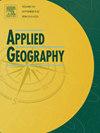Hidden gateways to digital space—the spatial distribution of Wi-Fi networks in the context of demographic structure in rural areas
IF 5.4
2区 地球科学
Q1 GEOGRAPHY
引用次数: 0
Abstract
This study examines the spatial distribution of Wi-Fi networks at a local scale in the context of demographic structure in rural areas. According to the main assumptions, Wi-Fi networks can be treated as hidden gateways to digital space. Identifying and mapping these hidden gateways can reveal the complexity of human activities as they function across real and digital spaces and in between them. The authors explore the influence of the local spatial distribution of different age groups on the distribution of Wi-Fi networks, as well as the correlation between the spatial patterns of hidden gateways and demographic structures. The research was conducted in the rural areas of five communes in Poland. Data were collected through the wardriving method using the WiGLE app and subsequently analysed employing geostatistical techniques. The results confirmed a relationship between population density and the number of Wi-Fi networks, indicating that areas with higher populations are more likely to have access to these networks. Additionally, the study found that the spatial distribution of Wi-Fi networks closely aligns with the presence of younger age groups, highlighting the role of demographics in shaping access to digital connectivity. This research suggests that future studies should integrate additional socioeconomic factors and investigate local Wi-Fi usage patterns through social analysis.
数字空间的隐藏网关——农村地区人口结构背景下Wi-Fi网络的空间分布
本研究考察了在农村地区人口结构背景下,本地Wi-Fi网络的空间分布。根据主要假设,Wi-Fi网络可以被视为通往数字空间的隐藏网关。识别和映射这些隐藏的网关可以揭示人类活动的复杂性,因为它们在真实空间和数字空间之间以及两者之间发挥作用。作者探讨了不同年龄组的局地空间分布对Wi-Fi网络分布的影响,以及隐蔽网关空间格局与人口结构的相关性。这项研究是在波兰五个公社的农村地区进行的。使用WiGLE应用程序通过wardriving方法收集数据,随后使用地质统计学技术进行分析。研究结果证实了人口密度和Wi-Fi网络数量之间的关系,表明人口较多的地区更有可能接入这些网络。此外,该研究还发现,Wi-Fi网络的空间分布与年轻群体的存在密切相关,突显了人口结构在塑造数字连接接入方面的作用。这项研究表明,未来的研究应该整合其他社会经济因素,并通过社会分析来调查本地Wi-Fi的使用模式。
本文章由计算机程序翻译,如有差异,请以英文原文为准。
求助全文
约1分钟内获得全文
求助全文
来源期刊

Applied Geography
GEOGRAPHY-
CiteScore
8.00
自引率
2.00%
发文量
134
期刊介绍:
Applied Geography is a journal devoted to the publication of research which utilizes geographic approaches (human, physical, nature-society and GIScience) to resolve human problems that have a spatial dimension. These problems may be related to the assessment, management and allocation of the world physical and/or human resources. The underlying rationale of the journal is that only through a clear understanding of the relevant societal, physical, and coupled natural-humans systems can we resolve such problems. Papers are invited on any theme involving the application of geographical theory and methodology in the resolution of human problems.
 求助内容:
求助内容: 应助结果提醒方式:
应助结果提醒方式:


